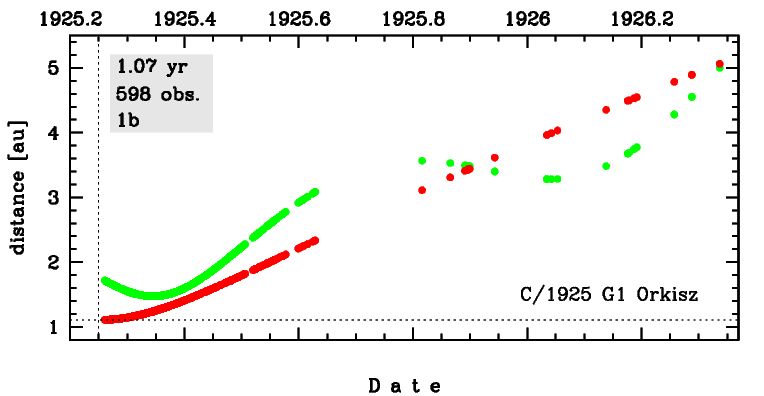C/1925 G1 Orkisz
more info
Comet C/1925 G1 was discovered on 3 April 1925 by Lucjan Orkisz (Astronomical Observatory at Łysina, currently Lubomir, near Kraków, Poland), that is two days after perihelion passage, and the comet was last seen on 12 May 1926 [Kronk, Cometography: Volume 3].
This comet made its closest approach to the Earth on 6 May 1925 (1.476 au), that is about one month after its discovery.
Solution given here is based on data spanning over 1.07 yr in a range of heliocentric distances from 1.111 au to 5.062 au.
This Oort spike comet suffers moderate planetary perturbations during its passage through the planetary system that lead to escape the comet from the planetary zone on a hyperbolic orbit (see future barycentric orbit).
This comet was in the original sample of 19 comets used by Oort for his hypothesis on LPCs; however, according to presented here statistics for previous perihelion passage this comet most probably is dynamically old.
More details in Królikowska et al. 2014.
This comet made its closest approach to the Earth on 6 May 1925 (1.476 au), that is about one month after its discovery.
Solution given here is based on data spanning over 1.07 yr in a range of heliocentric distances from 1.111 au to 5.062 au.
This Oort spike comet suffers moderate planetary perturbations during its passage through the planetary system that lead to escape the comet from the planetary zone on a hyperbolic orbit (see future barycentric orbit).
This comet was in the original sample of 19 comets used by Oort for his hypothesis on LPCs; however, according to presented here statistics for previous perihelion passage this comet most probably is dynamically old.
More details in Królikowska et al. 2014.
| solution description | ||
|---|---|---|
| number of observations | 598 | |
| data interval | 1925 04 05 – 1926 05 02 | |
| data type | observed only after perihelion (POST) | |
| data arc selection | entire data set (STD) | |
| range of heliocentric distances | 1.11 au – 5.15au | |
| detectability of NG effects in the comet's motion | NG effects not determinable | |
| type of model of motion | GR - gravitational orbit | |
| data weighting | YES | |
| number of residuals | 964 | |
| RMS [arcseconds] | 2.79 | |
| orbit quality class | 1b | |
| previous orbit statistics, both Galactic and stellar perturbations were taken into account | ||
|---|---|---|
| no. of returning VCs in the swarm | 5001 | * |
| no. of escaping VCs in the swarm | 0 | |
| no. of hyperbolas among escaping VCs in the swarm | 0 | |
| previous reciprocal semi-major axis [10-6 au-1] | 32.23 – 38.96 – 45.59 | |
| previous perihelion distance [au] | 370 – 840 – 1200 | |
| previous aphelion distance [103 au] | 43 – 50 – 61 | |
| time interval to previous perihelion [Myr] | 3.1 – 4 – 5.4 | |
| percentage of VCs with qprev < 10 | 1 | |
| percentage of VCs with qprev > 20 | 99 | |
| previous_g orbit statistics, here only the Galactic tide has been included | ||
|---|---|---|
| no. of returning VCs in the swarm | 5001 | * |
| no. of escaping VCs in the swarm | 0 | |
| no. of hyperbolas among escaping VCs in the swarm | 0 | |
| previous reciprocal semi-major axis [10-6 au-1] | 32.57 – 39.87 – 47.43 | |
| previous perihelion distance [au] | 0.98 – 1.2 – 3.1 | |
| previous aphelion distance [103 au] | 42 – 50 – 61 | |
| time interval to previous perihelion [Myr] | 3.1 – 4 – 5.4 | |
| percentage of VCs with qprev < 10 | 99 | |
| percentage of VCs with 10 < qprev < 20 | 1 | |
